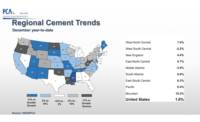Despite its associated energy costs and the availability of cheap imports from China and Pakistan, demand for cement in East Africa has continued to rise. The need to increase cement production to feed the region's booming construction industry dominated discussions at a workshop meeting of East African cement producers and German cement-equipment manufacturers in Nairobi, Kenya, on Nov. 20.
Annual demand for cement in East Africa is now estimated at 6 million metric tons, with Kenya’s demand alone estimated at some 3.5 million metric tons, according to Kenya's National Construction Authority (NCA).
East Africa's cement makers, including subsidiaries of German-based Heidelberg and French-based Lafarge, have sought to expand their existing capacities and construct new production lines to meet increasing demands for quality cement in the high-growth markets of the Democratic Republic of Congo, Rwanda and Burundi.
“The increasing demand is fueled by an upsurge in commercial projects, housing developments and mega government infrastructure projects, such as ports, railways and road-cement manufacturers, in East Africa,” says Maurice Akech, general manager of research, business development and capacity building at NCA.
With an estimated installed capacity of 4 million metric tons per year, Kenya is the leading cement producer in East Africa, with the installed capacity set to increase to 10 million metric tons per year by the end of 2015. Leading cement producers in East Africa include Bamburi Cement, Twiga Cement, Tanga Cement and East Africa Portland Cement Co. Sub-Saharan Africa’s largest cement producer, Dangote, currently is building a $500-million cement plant in Tanzania.
“Overall, in East Africa, capacity additions by 2018 are expected to increase the region’s cement capacity to 13.45 million [metric tons] per year,” says Akech.
Despite increased capacity, the cost of cement production in the region remains high because of the high cost of energy, says Pradeep Paunrana, managing director of Athi River Mining Cement Ltd., one of East Africa's leading cement makers.
Additionally, financing costs for cement manufacturers in East Africa remains high compared to Europe, which creates opportunities for firms based in the European Union to finance expanded cement production in East Africa, says Paunrana.
Members of the Association of German Machine Manufacturers (VDMA) told workshop attendees that investment in modern cement production equipment would make it possible to achieve quality product and reduction in overall production costs.
During the Nairobi workshop, German cement-equipment manufacturers offered technological solutions to produce quality cement at a lower cost than cement currently produced by East African manufacturers. “Standard compliant cement testing equipment is an important base for efficient and reliable quality control in cement production,” says Silvia Flachsel of Toni Technik, the Berlin-based subsidiary of Germany’s Zwick Roell Group, a leading global manufacturer of building-materials testing equipment.
East Africa cement producers can reduce the high cost of energy by upgrading or installing modern cement-grinding systems, says Uwe Karsunke of Beckum-based Christian Pfeiffer, a leading provider of grinding systems components in Germany. “Upgrading potential in closed grinding circuits could lead to better-quality cement and lower energy consumption,” he says.
At the workshop, German cement-equipment manufacturers and cement makers expressed concern over increasing importation of cheap cement from China and Pakistan into East Africa. “The main challenge for machine and manufacturers is how to compete with China,” said Ulrich Guertler, the CEO of Nairobi-based UG Cement Consult Ltd.
Guertler says that, although the quality of Chinese cement is similar to that of Eastern Europe and India, its role in East Africa cannot be ignored. He also called for a change of mind-set by European cement manufacturers to effectively compete with Chinese competitors.
“Some of the European cement manufacturers still insist that their plant equipment has to come from Europe. We must reach a compromise with the Chinese, and that is happening already,” he says.


Post a comment to this article
Report Abusive Comment